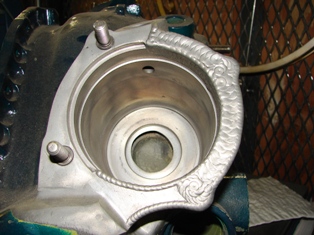Welding metallurgy of Magnesium alloys..Day 5 of Down and Dirty Metallurgy

Learn more about TIG welding Welcome to Day 5 of your crash course on down and dirty welding metallurgy.
Welding Magnesium Alloys... the pros called it "Mag"
Remember all the times I have said that Carbon steel, cast iron, low alloy steels like 4130 chromoly, and straight chromium stainless steel like 410 all harden from heating and then quick cooling? And that Almost everything else does not harden from heating and quenching? And that If you didn’t get this yet, to read it again?
Did you do it? OK here we go then. Next lets talk some more about the down and dirty welding metallurgy of magnesium. Magnesium will not harden by heating and quenching. Some magnesium alloys will respond to an aging heat treatment. (Meaning if the part is allowed to reach an elevated temperature for a certain length of time, then certain phases will form that increases the strength significantly.)
If you have Tig welded magnesium, you are one of less than 1% of all welders in the world. Seriously, there is just not that much magnesium welded in the world compared to aluminum and steel which comprise fully 90 percent of all welding. Magnesium alloys contain varying mixes of aluminum and/or zinc and/or rare earth elements and/or thorium. Depending on the mix, some alloys are more prone to cracking and other problems. I will keep this as simple as possible since this is the down and dirty welding metallurgy series. There are several different magnesium alloys but a lot of the welding is done during repair of magnesium castings. Gearbox housings for aircraft and helicopters are often made of magnesium. The castings differ but welding techniques for magnesium castings are as follows no matter the alloy of the casting:
The castings are likely to be oil soaked and therefore preheat at or near the maximum allowed will sometimes allow the oil to leach out of the pores which dramatically improves weldability
• The Tig welding arc length should be much, much tighter than with aluminum. So close that you will think the electrode is actually touching. This allows fusion with less amperage and also allows for smaller beads. Smaller beads are less likely to cause cracking and are less likely to contain porosity. Another benefit of small beads is that they allow for a carbide burr to be used to check for porosity. Porosity in castings is normal and should be expected. Welds deposited on mag castings will often have porosity because of oil and existing pores and the deposited weld will often will have to be removed by a carbide burr several times before contaminants cook out enough to allow for a sound weld to be deposited and then built upon. This takes patience and determination but it often works. It is worth all the effort on a 50,000 dollar aircraft gearbox, not so much on 100 dollar Husqvarna chainsaw housing.
Some more tips for welding mag castings are: Use welding machine with squarewave and a/c balance control Use a 50/50 argon/helium mix Preheat with an acetylene /air torch or a large volume propane torch Get some temp sticks to verify preheat temperature Clean all the coatings and paint in the weld area Clean the welding wire with steel wool Have two grinders handy, one with a stainless steel wire brush, the other with a course carbide burr Use minimal heat and run small short beads Wire brush often welding metallurgy boring you?
















